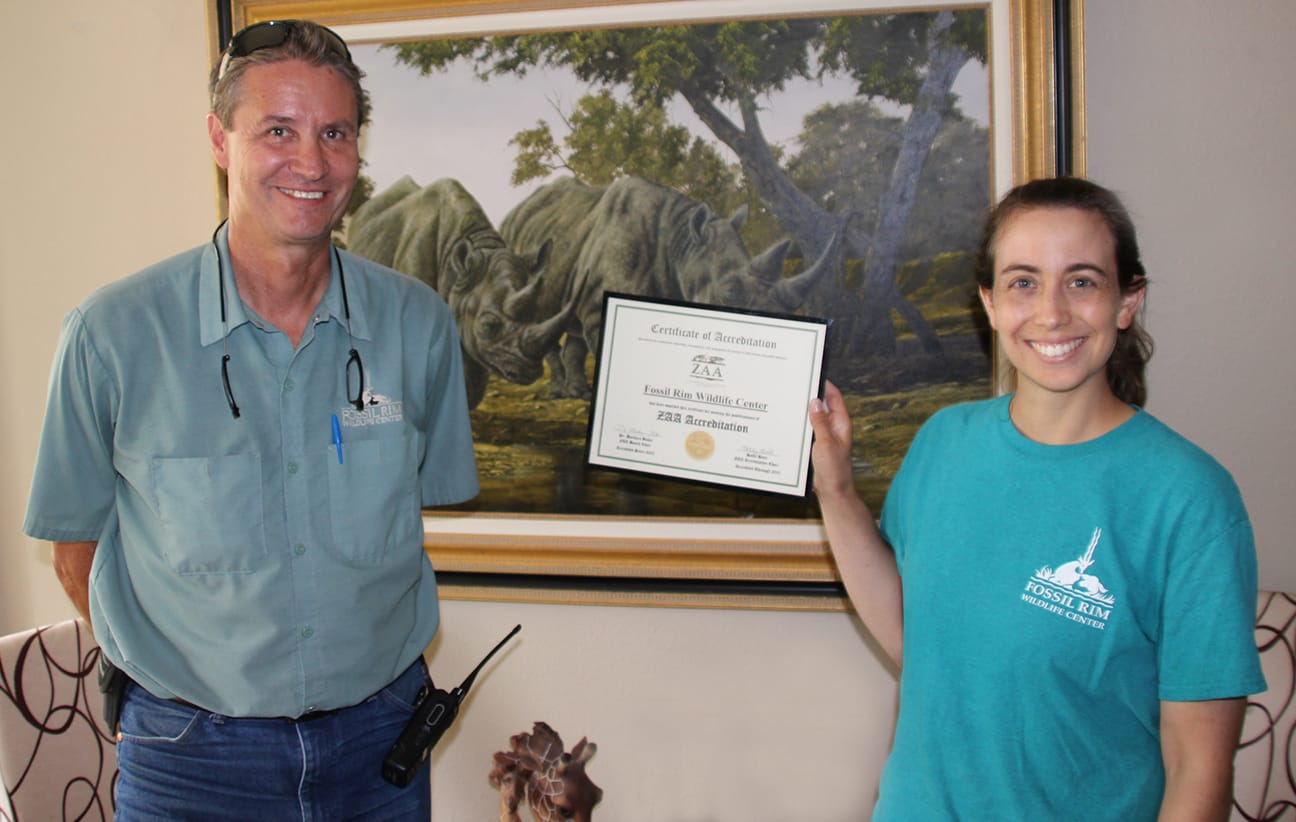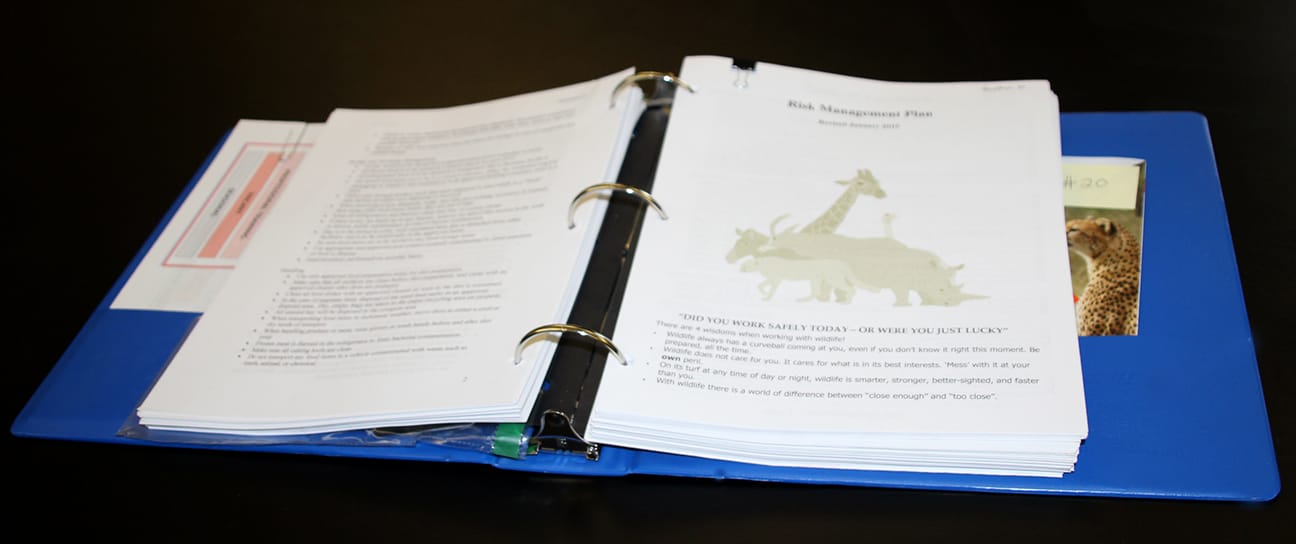And so the streak continues!
Accredited with the Zoological Association of America (ZAA) since 2005, Fossil Rim recently learned that its reaccreditation bid was successful and will remain valid until 2025.
Director of Animal Care Adam Eyres discussed how remaining in good standing with ZAA helps Fossil Rim.
“I think the benefit for Fossil Rim being accredited is it provides us better opportunities to collaborate with people and organizations in the wildlife industry,” he said. “It increases the number of people we can work with, ask questions of, collaborate with, and get advice from. When dealing with another zoological institution for the first time, it is helpful to know they are ZAA-accredited. I’m sure some facilities may hinge their approval on that alone.


“We still vet the people we work with, but accreditation by ZAA is a factor we take into consideration. When an inspection is coming up, going through this process is very helpful for us to make sure Fossil Rim meets a high standard. Those are some of the reasons I like being accredited.”
In a letter to Executive Director Kelley Snodgrass, ZAA Executive Director John Seyjagat pointed to five organizational objectives that Fossil Rim continues to meet in order for the reaccreditation to be approved.
The first objective is “professional standards for husbandry and animal care practices.”
“ZAA has their standards that we need to live up to,” Eyres said. “That’s why they have the inspection and send a team out to see our facilities and animals. But, we would keep our standards high no matter what.
“On that note, we are also held to standards by the USDA (United States Department of Agriculture) and they do surprise inspections annually. It is important to have that oversight so that people know we’re doing what we should be doing.”
The second objective is “accurate animal and medical records.”
“Our records are excellent,” Eyres said. “ZAA requires that we have records to be accredited, but we have records anyway because it allows us to do our jobs most effectively. The hoofstock department does a daily report and I read those every day. The carnivore department does a daily report and (Carnivore Curator) Jason (Ahistus) reads those every day.
“The activities of our Attwater’s prairie chicken staff are fully transparent because of the detailed database maintained on those birds. The veterinarians enter all of their medical records.”
“I help with transaction paperwork for animals arriving at or leaving Fossil Rim,” said Executive Coordinator Kristen Hannah, who is the person to organize and submit the accreditation application. “Everyone in animal care and animal health is involved in recordkeeping for the animals under their care.”
The third objective is “appropriate, safe, and quality existence for animals kept in a captive environment.”
“That objective is all about emphasizing good animal welfare,” Eyres said. “Everyone on staff does what is in the best interest of the animals.
The fourth objective is “safe environment for humans – both staff and visitors.”
“A huge portion of the application is about responses to various types of emergencies – for example, evacuation plans,” Hannah said. “Also, matters like how much contact staff can have with certain animals or how much contact our guests can have with certain animals. There are many safety questions, so we include numerous safety protocols regarding people and animals.”
The fifth-and-final objective is “enhanced survival of species using appropriate methods.”
“That objective asks the question of ‘Are we helping to conserve species, as opposed to just providing some animals for the public to see?’” Eyres said. “We are, overall, a conservation breeding facility and most of the species at Fossil Rim are here to produce offspring as an assurance policy against extinction. We are involved in American red wolf, Mexican wolf, scimitar-horned oryx, and Attwater’s prairie chicken recovery projects in the wild.
“We are also a holding facility for Przewalski’s horses (4) and bontebok (1), which means we provide space to house animals from facilities that are breeding them. When those facilities have male offspring, they can run out of space, so we step in with our large pastures and provide space so that those breeding facilities can continue to produce animals.
“We’ve taken those extra males. Hopefully, all of our Przewalski’s horses go to breeding situations one day, but even our current role as a holding facility for them plays a role in conservation.”
For Hannah, an upcoming reaccreditation means she is taking on a monumental task behind the scenes.
“There are hundreds of pages to an application; this one was substantially longer than our last ZAA application,” Hannah said. “I might begin to prepare the application anywhere from 6-12 months in advance. On the years we are preparing for a reaccreditation, it is a significant part of my job. I spend numerous hours coordinating with the different departments to update their policies.

“I do a lot of proofreading, organizing, and emailing to pull things together. I keep a digital folder and I’m mindful of whether or not a particular item could be important for an application or other projects later on.”
Speaking of something being important later on, Eyres does not wait around to have his staff make updates and improvements at the last minute with an inspection looming.
“We may get accredited every five years, but things are changing all the time,” he said. “We are responsible for staying up-to-date, regardless of what year the inspection is scheduled. You can’t just put everything off until a reaccreditation year.”
Hannah said that most Fossil Rim directors contribute to the reaccreditation process and the various curators work on updates to existing Fossil Rim policies. Many others on staff are quick to help when questions specific to their area are on the application. She elaborated on the process and the importance of accuracy.
“The process involves the written application and then an inspection several months later,” she said. “We had two inspectors and it was a full day of visiting all the areas of the park. For anything you submit on the application, they can and likely will ask you about it.
“If you recite it differently, that discrepancy could raise a question on their end. I submit the application, but they’ll ask the appropriate person in that particular department.”
Eyres added that when inspectors arrive, he – along with Snodgrass and Hannah – sits down with them to organize the day’s schedule. Then, they head out and evaluate everything they need to, filling out a detailed inspection form along the way.
For Fossil Rim guests reading this blog who might not have been aware of ZAA or the need for accreditation at wildlife facilities, what should they take away from this news?
“ZAA is a great organization to be accredited by, because it puts us alongside other quality zoological organizations,” Eyres said. “Strength in numbers, you might say. Having colleagues that you know operate at a high level is important.”
Eyres pointed to essential current information that ZAA provides.
“If the government changes regulations regarding exotic animals, ZAA will lobby on behalf of their organizations,” he said. “They keep track of legal developments and provide weekly updates with important information. If they didn’t provide these updates, we’d be responsible for tracking all of that ourselves. We look at the updates and can adjust management of our programs accordingly.”
Member organizations can help ZAA, as well. When an organization applies for ZAA accreditation, existing members have the opportunity to weigh in with feedback they have about the applicant.
“That helps ZAA weed out some organizations that may not meet their standards at this time,” Eyres said.
He looks forward to maintaining Fossil Rim’s good standing in perpetuity.
“We have every intention of continuing to be ZAA-accredited into the future,” he said. “Our initial accreditation in 2005 was through (former Fossil Rim Executive Director) Dr. (Pat) Condy, because he was very involved in the organization and still serves on their board of directors. There is no reason for us to stop striving to meet the quality standards they uphold.”
-Tye Chandler, Marketing Associate

